

Wilkinson. Indian-Commerce-Clause. Land of the Indians - Indiana. Land of the Indians - Indiana. Expanded%20Homestead%20Timeline%20final. 25 U.S.C. § 177 : US Code - Section 177: Purchases or grants of lands from Indians. Indian Lands. The examination of Indian lands is really a study of history, international law and governmental policy.
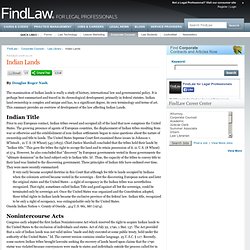
It is perhaps best summarized and traced in its chronological development, primarily in federal statutes. Indian land ownership is complex and unique and has, to a significant degree, its own terminology and terms of art. General Indian Legislative History. Outline of United States federal Indian law and policy. Law and U.S. public policy related to Native Americans has evolved continuously since the founding of the United States.
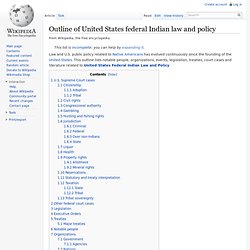
This outline lists notable people, organizations, events, legislation, treaties, court cases and literature related to United States Federal Indian Law and Policy. U.S. Supreme Court cases[edit] Citizenship[edit] Adoption[edit] Burke Act. Burke Act (1906), also known as the Forced Fee Patenting Act, was designed to correct certain defects in the Dawes Act of 1887 (formally known as the General Allotment Act ("GAA"), under which the communal land held by tribes on the Indian reservations was broken up and distributed in severalty to individual households of tribal members.
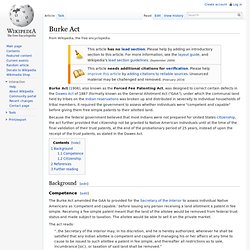
It required the government to assess whether individuals were "competent and capable" before giving them free simple patents to their allotted land. Because the federal government believed that most Indians were not prepared for United States citizenship, the act further provided that citizenship not be granted to Native American individuals until at the time of the final validation of their trust patents, at the end of the probationary period of 25 years, instead of upon the receipt of the trust patents, as stated in the Dawes Act. Background[edit] Indian Citizenship Act. President Coolidge stands with four Osage Indians at a White House ceremony The Indian Citizenship Act of 1924, also known as the Snyder Act, was proposed by Representative Homer P.

Snyder (R) of New York and granted full U.S. citizenship to America's indigenous peoples, called "Indians" in this Act. (The Fourteenth Amendment already defined as citizens any person born in the U.S., but only if "subject to the jurisdiction thereof"; this latter clause was thought to exclude certain indigenous peoples.) The act was signed into law by President Calvin Coolidge on June 2, 1924.[1][2][3] It was enacted partially in recognition of the thousands of Indians who served in the armed forces in WWI. Text[edit] Native American Graves Protection and Repatriation Act. The Native American Graves Protection and Repatriation Act (NAGPRA), Pub.
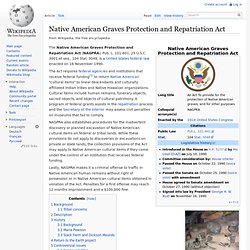
L. 101-601, 25 U.S.C. 3001 et seq., 104 Stat. 3048, is a United States federal law enacted on 16 November 1990. The Act requires federal agencies and institutions that receive federal funding[1] to return Native American "cultural items" to lineal descendants and culturally affiliated Indian tribes and Native Hawaiian organizations. Cultural items include human remains, funerary objects, sacred objects, and objects of cultural patrimony.
American Indian Religious Freedom Act. The American Indian Religious Freedom Act, Public Law No. 95-341, 92 Stat. 469 (Aug. 11, 1978) (commonly abbreviated to AIRFA), codified at 42 U.S.C. § 1996, is a United States federal law, enacted by joint resolution of the Congress in 1978.
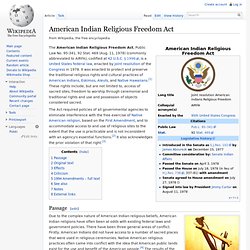
It was enacted to protect and preserve the traditional religious rights and cultural practices of American Indians, Eskimos, Aleuts, and Native Hawaiians.[1] These rights include, but are not limited to, access of sacred sites, freedom to worship through ceremonial and traditional rights and use and possession of objects considered sacred. The Act required policies of all governmental agencies to eliminate interference with the free exercise of Native American religion, based on the First Amendment, and to accommodate access to and use of religious sites to the extent that the use is practicable and is not inconsistent with an agency's essential functions.[2] It also acknowledges the prior violation of that right.[3] Passage[edit] Original text[edit] Alaska Native Claims Settlement Act. The Alaska Native Claims Settlement Act (ANCSA) was signed into law by President Richard M.
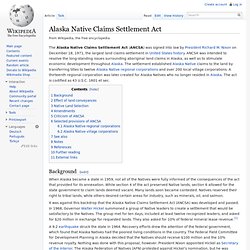
Nixon on December 18, 1971, the largest land claims settlement in United States history. ANCSA was intended to resolve the long-standing issues surrounding aboriginal land claims in Alaska, as well as to stimulate economic development throughout Alaska. The settlement established Alaska Native claims to the land by transferring titles to twelve Alaska Native regional corporations and over 200 local village corporations.
A thirteenth regional corporation was later created for Alaska Natives who no longer resided in Alaska. The act is codified as 43 U.S.C. 1601 et sec. Indian Self-Determination and Education Assistance Act of 1975. The Indian Self-Determination and Education Assistance Act of 1975 (Public Law 93-638) authorized the Secretary of the Interior, the Secretary of Health, Education, and Welfare, and some other government agencies to enter into contracts with, and make grants directly to, federally recognized Indian tribes.

The tribes would have authority for how they administered the funds, which gave them greater control over their welfare. The ISDEAA is codified at Title 25, United States Code, beginning at section 450. Signed into law on January 4, 1975, the ISDEAA made self-determination the focus of government action. The Act reversed a 30-year effort by the federal government under its preceding termination policy to sever treaty relationships with and obligations to Indian tribes. Native American Languages Act of 1990.
The Native American Languages Act of 1990 is the short cited title for executive order PUBLIC LAW 101-477 enacted by Congress on October 30, 1990.

Public Law 101-477 of 1990 gave historical importance as repudiating past policies of eradicating Indian Languages by declaring as policy that Native Americans were entitled to use their own languages. The fundamental basis of the policy's declaration was that the United States "declares to preserve, protect and promote the rights and freedoms of Native Americans to use practice and develop Native American Languages".[1] In addition, to "fully recognize the right of Indian Tribes and other Native American governing bodies, States, territories, and possessions of the United States to take action on, and give official status to their Native American languages for the purpose of conducting their own business".[1] Provisions[edit] SEC. 104.
History[edit] Indian Reorganization Act. The Indian Reorganization Act of June 18, 1934, sometimes known as the Indian New Deal, was U.S. federal legislation that secured certain rights to Native Americans (known in law as American Indians or Indians), including Alaska Natives.[1] These include actions that contributed to the reversal of the Dawes Act's privatization of communal holdings of American Indian tribes and a return to local self-government on a tribal basis.
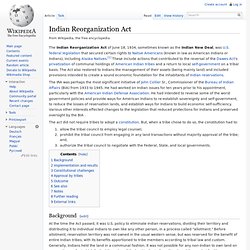
The Act also restored to Indians the management of their assets (being mainly land) and included provisions intended to create a sound economic foundation for the inhabitants of Indian reservations. The act did not require tribes to adopt a constitution. But, when a tribe chose to do so, the constitution had to: Oklahoma Indian Welfare Act. The Thomas-Rogers Act was adopted because congress had previously dissolved sovereign tribal governments in Oklahoma and Indian Territories to pave the way “for Oklahoma’s admission to the union on an ‘Equal footing with the original States.
"[6] Prior to statehood, the land of the former reservations in Oklahoma was: allotted to individual Indian Tribal membersheld in trust by the United States for the benefit of tribal members, orotherwise disseminated to non-Indians in a series of land runs Major points of the act[edit] External links[edit] See also[edit] Former Indian Reservations in Oklahoma References[edit]
Indian Civil Rights Act of 1968. The Indian Civil Rights Act of 1968 applies to the Indian tribes of the United States and makes many, but not all, of the guarantees of the Bill of Rights applicable within the tribes. [1] The Act appears today in Title 25, sections 1301 to 1303 of the United States Code. Events before passage of ICRA[edit] The U.S. Supreme Court had made clear that tribal internal affairs concerning tribal members' individual rights were not covered by the Fifth Amendment; however, the tribes were ultimately subject to the power of Congress and the Constitution.[2] The court case Talton v. Mayes helped establish these principles. Removal Act of 1830. Indian Removal Act. The Indian Removal Act was a law passed by Congress on May 28, 1830, during the presidency of Andrew Jackson. It authorized the president to negotiate with Indian tribes in the Southern United States for their removal to federal territory west of the Mississippi River in exchange for their homelands.[1][2][3] The act was strongly supported by non-native people of the South, who were eager to gain access to lands inhabited by the Five Civilized Tribes.
Christian missionaries, most notably Jeremiah Evarts, protested against its passage. Background[edit] President Andrew Jackson called for an Indian Removal Act in an 1829 speech. In the 1823 case of Johnson v. Indian removal. Early in the 19th century, while the rapidly-growing United States expanded into the lower South, white settlers faced what they considered an obstacle. This area was home to the Cherokee, Creek, Choctaw, Chicasaw and Seminole nations. Indian Treaties and the Removal Act of 1830 - 1830–1860 - Milestones - Office of the Historian. Indian Treaties and the Removal Act of 1830 The U.S. Government used treaties as one means to displace Indians from their tribal lands, a mechanism that was strengthened with the Removal Act of 1830.
In cases where this failed, the government sometimes violated both treaties and Supreme Court rulings to facilitate the spread of European Americans westward across the continent. Andrew Jackson. Civilization Fund Act. Land Act of 1820. Dawes Act. Poster. Curtis Act of 1898. Nonintercourse Act.